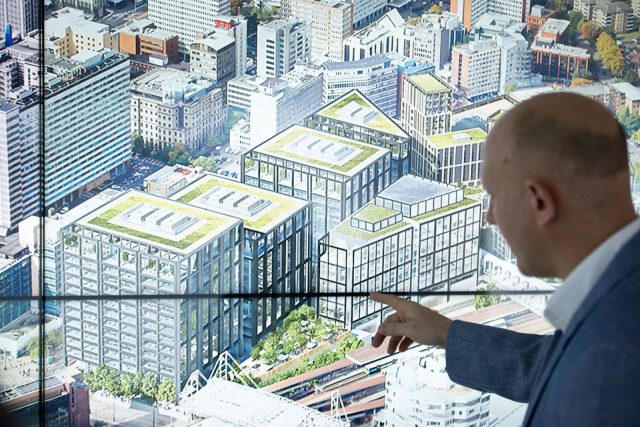
When we talk about smart cities, our minds usually jump to images of self-driving cars, seamless public transit, or perhaps a city-wide network of public Wi-Fi. We imagine a sleek, futuristic world where everything just works. But what we often overlook is the complex, invisible circulatory system that powers this vision: the electrical grid. As cities become more connected, integrating everything from a single smart thermostat to a massive network of IoT devices, we face a critical paradox. The very technology that makes a city “smart” also introduces new and complex challenges to electrical safety. This isn’t just about keeping the lights on; it’s about protecting people and property in an increasingly complex urban landscape. This is precisely where urban planning visualization and, more specifically, urban design rendering, emerge as indispensable tools. We’re moving beyond simple 2D blueprints to a comprehensive, three-dimensional representation of a city’s vital infrastructure. Visualizing a city’s electrical grid isn’t just an aesthetic flourish; it’s a critical, proactive step toward building a safer, more resilient urban future for all of us.
The Evolving Electrical Grid: A New Frontier of Risk
Think about a city’s traditional power grid. It’s a relatively straightforward, one-way street: power flows from a central source to homes and businesses. But now, as we build smart cities, this model is becoming obsolete. The modern grid is a dynamic, multi-directional network. New technologies—large-scale renewable energy sources, countless electric vehicle charging stations, and a dense web of interconnected IoT devices—create new patterns of energy consumption and, crucially, a two-way flow of power. Imagine a neighborhood where every home has solar panels, contributing power back to the grid on a sunny day. This is great for sustainability but creates a massive headache for legacy infrastructure, which often struggles to handle this bidirectional complexity. This can lead to a whole host of risks, from circuit overloads and unpredictable power surges to increased vulnerability to both physical and cyber threats. A single weak point in this intricate web could, quite literally, have city-wide consequences. The sheer density and interconnectedness of smart city systems demand a more advanced approach to planning and risk mitigation—one that can see the unseen and predict the unpredictable.
Urban Design Rendering as a Proactive Tool
So, how do we tackle these challenges? This is where urban design rendering steps in as a game-changer. What exactly is it? At its core, it’s the process of creating highly detailed, realistic 3D visualizations of urban environments. But for city planners and electrical engineers, it’s so much more than a pretty picture. These renders don’t just show you buildings and parks; they can model the intricate, often-invisible electrical infrastructure—the power lines, the substations, the smart meters, and the thousands of connections that make a smart city tick. This technology enables us to identify potential spatial conflicts and safety hazards long before a single shovel breaks ground. We can see if a new building’s planned location will interfere with existing power lines or if a new development will overload a local substation. It allows us to resolve issues in a virtual world, saving us from costly, time-consuming, and potentially dangerous mistakes in the real one. In essence, it’s a proactive diagnostic tool for a city’s nervous system. The creation of compelling urban design renders allows stakeholders to see, understand, and correct issues with the electrical infrastructure before they become a real problem.
The Power of the Digital Twin: Simulating Safety Scenarios
If an urban planning rendering is a static picture, a digital twin is a living, breathing movie. Think of it as a virtual, real-time replica of a city’s electrical grid. This isn’t just a model; it’s a dynamic simulation that uses real-time data from IoT sensors to mirror the physical grid’s behavior. With a digital twin, we can run once impossible simulations. For instance, we could model the impact of a sudden power surge, caused by a massive spike in EV charging, and see exactly which parts of the grid would be affected. We can also simulate the effects of a severe weather event, like a hurricane or an ice storm, on the electrical network, allowing us to test and refine our emergency response plans. This predictive capability is essential for proactive maintenance, optimizing resource allocation during an emergency, and continuously improving the resilience of the urban power supply against both natural and human-made threats. This type of urban design plan rendering allows for a level of foresight that was unimaginable just a few years ago.
A Collaborative Approach for a Secure Future
Ultimately, advanced visualization techniques aren’t just for engineers and planners. They are potent tools for transparent communication and collaborative decision-making across the board. They help bridge the gap between technical experts and the public, making complex issues understandable to everyone. Whether you’re a government official, a developer, or a concerned citizen, a clear city planning rendering can help you understand the impact and benefits of a project. Using visualization to communicate these complex plans is key to getting buy-in and building a secure future. Here are the key benefits of using these tools for electrical safety:
- Proactive Hazard Identification: These visualizations allow for the early detection and correction of potential electrical risks and spatial conflicts in infrastructure design, which can prevent accidents and outages.
- Enhanced Stakeholder Communication: A detailed urban design project rendering provides a transparent, universally understandable visual medium for communicating complex electrical plans to non-technical parties, fostering trust and collaboration.
- Data-Driven Decision Making: By integrating real-time data from IoT sensors and other sources, we can create a “living” model of the grid for informed planning and continuous improvement.
- Improved Emergency Preparedness: Dynamic simulations enable us to test and optimize emergency response and recovery plans for electrical systems in various disaster scenarios.
- Cost and Time Savings: Resolving issues in the digital phase reduces the need for costly physical revisions and prevents project delays, making development more efficient.
Conclusion
As our cities continue their march toward a brighter, more connected future, so too must our approach to public safety and infrastructure management. We cannot build the cities of tomorrow using the tools of yesterday. The integration of advanced visualization, from a simple urban design rendering to the complex power of digital twins, is the essential technology that bridges the gap between raw data and human understanding. It empowers city planners and engineers to build smarter, safer, and more resilient urban environments. This isn’t just a technological advancement; it’s a fundamental shift in how we approach urban development—one that puts foresight and proactive safety at the very heart of the design process. The future of our cities isn’t just about what we build, but how we see it, plan it, and make it safe for everyone.




